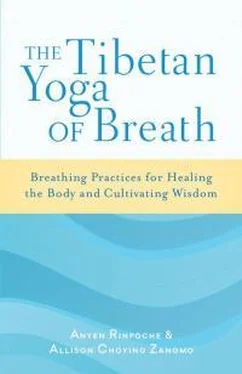There is no place in the world that we could go that does not have its own characteristic, accordant suffering. We do not suffer because we have done something wrong, and we do not suffer because we “deserve” it. We are not somehow flawed because we experience life as painful and difficult. This is simply the world we live in.
Do not mistake the meaning of this contemplation, thinking it to be an exercise in being judgmental. The point is not that people are inherently selfish or wrong. The point is to realize that each and every being must face suffering, and the suffering they must face is distinct based on the circumstances and the unique features of their lives.
So often we think to ourselves, “If I only had what that person has, I would not have to face the suffering that I have now.” In fact, that may be true—that person may not be facing the same suffering we are because his or her life may contain hundreds of variables different from our own. One thing is certain: that person is facing suffering derived from their specific circumstances.
Once we have become certain that suffering is all-pervasive through extensive reflection and contemplation, such as suggested above, we can use wind energy training on the cushion as well as in our everyday lives to help us face the difficult situations before us each day.
As we learned in chapter 6, mindfulness linked with introspection is an indispensable tool for working with our minds on a moment-by-moment basis. When we face difficulties, our practice will do us no good if we forget to use it! It is important that we constantly try to cultivate awareness of what is happening in the mind, and also awareness of our respiratory rate and how we are breathing. Otherwise, we lose the chance to influence our breathing rate and patterns, and thus relax body and mind.
When we lack awareness about what is happening in our own minds, and awareness of the breath, we think, “I need to escape from this life that I’m living.” But when we become more skillful at remembering to use wind energy training in the face of difficult situations, the question is not, “To where will I escape?” It becomes, “How do I remain in my ordinary life now, but decrease the experience of suffering?” When we recognize that we are chasing after the fantasy that someone else has a life that is somehow better than what we have, and then come back to the breath, our own personal experience of suffering decreases. We are able to act mindfully and thoughtfully to benefit others, and we become happier ourselves.
Exercise 21

CONTEMPLATE SUFFERING WITH AWARENESS OF THE BREATH
Probably, when we think about working with difficult situations as part of our spiritual practice, we are thinking about the contentious or painful moments we face in our daily lives. As practitioners of wind energy training, we can use our training to help us face those difficult moments. However, formal sitting on the meditation cushion is also extremely important. Without sitting on the cushion, taking time to reflect on the miserable nature of samsara, and developing loving-kindness and compassion, we will struggle to make a strong emotional and spiritual connection.
As we learned in chapter 4, we begin our sitting practice with a short session of yoga, sit in the Seven-Point Posture, generate a compassionate motivation, and then practice the Nine-Cycle Breathing. Next, we simply work with the inhalation and exhalation naturally as we contemplate the nature of samsara. When we contemplate the nature of samsara as a sitting practice, we can use the contemplations presented earlier in this chapter, or we can reflect on the all-pervasive nature of suffering in any way that helps us to emotionally connect with and accept this truth. If we notice the mind becoming upset or agitated by our reflecting on the sufferings of ourselves and others, we can place more attention on elongating the breath as we inhale and exhale to help ourselves relax. Or we can simply drop the contemplation for a few minutes, and simply focus one-pointedly on the breath until we relax again.
Exercise 22

CULTIVATE LOVING-KINDNESS
If we feel ready to move beyond simply reflecting on the nature of samsara, we can change our formal sitting practice slightly.
After we have prepared for sitting practice by doing a short session of yoga, sitting in the Seven-Point Posture, generating a compassionate motivation, and practicing the Nine-Cycle Breathing, we can generate loving-kindness and compassion for others. This is traditionally done in Buddhist practice by using a very simple prayer, and we can combine this prayer with the inhalation and exhalation of the breath.
Begin by thinking, “May beings be free of suffering and the cause of suffering,” and inhale. Then exhale, thinking, “May beings have happiness and the cause of happiness.” Keeping the words of this prayer in mind, we can kindle the twofold wish contained within the prayer within our own heart as we focus one-pointedly on the inhalation and exhalation of the breath. We can recall our own suffering, the suffering of a loved one, or even that of a being we have never met. We can work with this verse as often as we like, sometimes resting quietly and simply focusing on the breath until we finish our session of sitting meditation.
Exercise 23

PRACTICE TONGLEN
After working with the prayer above for several weeks or perhaps months, we will start to develop a genuine wish for beings to be free of suffering and to experience happiness. When that wish surfaces naturally within us, we can again change our formal sitting practice and start working with the wind energy training called Tonglen .
Tonglen is a Tibetan word that is literally translated as “sending and receiving.” What are we sending? We are sending out the breath, along with our own peace of mind, happiness, and our good wishes to all living beings. What are we receiving? We are taking in the breath, and also metaphorically taking on the suffering of others. In other words, we mentally wish to develop the ability to take on the suffering of others. We need not be frightened by this practice. We are just ordinary beings, and we are not actually capable of taking on another’s suffering. Any fears that may come up in the mind are just our self-attachment talking!
We can also apply the wind energy practice of Tonglen to ourselves and the difficulties we face in our own lives. As we are sitting on the cushion, we can bring to mind anything that is bothering us. The mind is constantly recycling patterns of thought, and whether they are really important or not, those thoughts cause us to suffer. So we need not worry about not having something to work with for this practice. No matter what comes up in the mind, we think, “How many other beings there must be on the planet who are suffering in a similar way at this moment.” As we inhale, think, “May I take on that suffering for them, since I am already suffering.” Then, as we exhale, whether or not we really feel great, we bring to mind a feeling of calm and relaxation and think, “May all sentient beings feel peace of mind and harmony.” We imagine that we are sharing that with others as we send out the breath.
Exercise 24

WIND ENERGY TRAINING AS HEALING
Tibetan medicine is very effective, but there are certain illnesses it can’t heal—diseases such as leprosy or HIV/AIDS, autoimmune diseases, cancer, and illnesses that require treatment by antibiotics. The highly developed and expensive medical treatments needed for these types of illnesses were historically unavailable in Tibet. As a result, many Tibetans had to rely instead on spiritual practice for healing. Fortunately, many lamas of old, who had great spiritual capacity and realization, were able to cure even these serious kinds of illnesses based on a practice such as Tonglen.
Читать дальше













